Palm trees are beautiful but may not last forever. However, as your plans change for your property, there’ll come a time that it has to go, leaving you with a palm tree stump in your yard.
In this post, we’ll share with you different methods of palm tree stump removal and how to do them DIY style.
Your palm tree may have served its purpose but removing it including its stumps will open a new space for plants to grow and better additions to your lawn.
What To Expect in a Palm Tree Stump?
The look of a palm tree would immediately give anyone a tropical vibe. These tropical trees have a hundred thin roots that only expand in length and not in size like other trees.
So the older the palm tree the deeper the roots grow. It may take a while to reach the root ball since the hair-like branches of roots may get in the way.
Roots of young palm trees are shallow and can be easily removed by hand. However, old palm trees may take hours or even days to remove.
So, if you have the old ones, brace yourself for a day of physical labor, or let’s just say a workout.
Advantages of Removing a Palm Tree Stump

Palm tree stumps may stay around your property for a few good reasons like serving as an outdoor chair. However, they also keep you away from the following opportunities:
- Additional space for a garden: Palm tree stumps may take up an excellent space to plant new types of floras in your garden. These stumps may also give the tree a chance to regrow so if you’re no longer interested in having a tree, you might as well remove it.
- Spotless green lawn: Having a tree stump in the middle of the green lawn will not sit well with the neat conscious homeowners.
- A flat foundation for new buildings in your yard: Leveling the ground and ground and removing the stumps in the area is the first thing that you should do if you’re planning on extending a deck or a pagoda on your property.
- A clear field for kids to play around: If you have kids letting them run around a field with a tree stump is not a good idea. Any obstacle may cause accidents so getting rid of the tree stump is like babyproofing your outdoor area at home.
- Getting rid of potential animal and insect den: Yellowjacket hornets and skunks are fond of staying in woody areas. If the palm tree stump provides an ideal spot for these animals to stay on it, you’ll be surprised to see new nests and den around.
- Generally improving the look of your garden: Overall, tree stumps don’t look great in a garden. Unless you make something creative to give them another purpose, they will remain a waste of space and an obstacle for your landscape.
4 Different Methods For Palm Tree Stump Removal
Removing a palm tree stump can be done in four different ways. The method that will be suitable for you will only depend if you have abundant time to remove it by hand or you have the equipment to do the removal job for you.
To make it easier for you to weigh the pros and cons of each method. Here are some palm tree removal options for you to choose from:
Method 1: Removing Palm Tree Stump By Hand
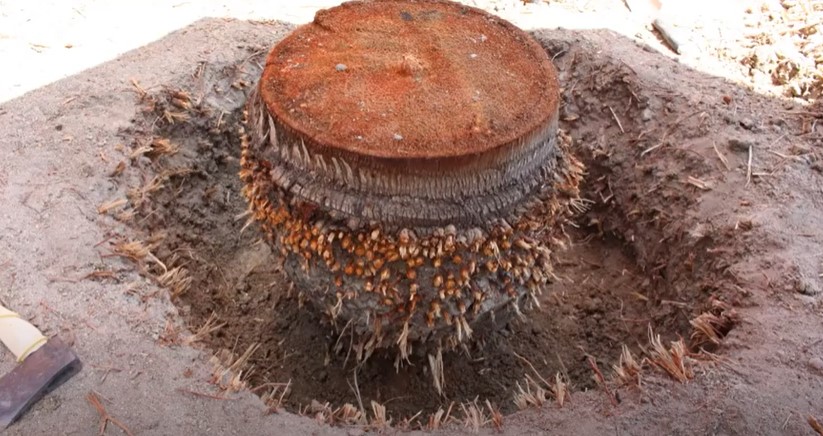
If you’ve been reading our blog posts here in Our Garden Works, chances are you’re also a DIY junkie.
Well, if you do, the good news is that you can remove it by hand. You might be thinking of turning like The Hulk and pulling it out is an option, sorry to break this to you but no, sorry!
Here’s what we, humans, can do. The idea is to disconnect the trunk and root ball from the branches of its roots underground and divide the trunk like a pizza with a chainsaw.
Sounds tough? It’s doable! Check out our guide below:
How To Remove a Palm Tree Stump By Hand?
Before working on the tree stump, make sure that you’re wearing protective gears since you’ll be using a chainsaw and other sharp materials for this activity. Here are the materials you’ll need:
Materials:
- Chainsaw
- Crowbar
- Pick
- Ax
- Shovel
- 4 Triangle wood inserts
- Sledge hammer
Procedure:
- Trim the stump using the chainsaw to its lowest possible height. Doing so will help make each piece lighter and make it easier to detach the parts of the trunk later.
- Dig around the tree stump and start disconnecting the trunk from the roots using an ax or a pick.
- While detaching the roots, remove the soil around it too to expose the depth of the stump and the root ball. Continue this procedure until you reach the bottom of the root ball.
- Using the chainsaw, cut the trunk in half and make another cut to divide the trunk into four. Simply put, it’s like cutting a pizza.
- Change the shape of the wood inserts and make one end of the triangle thin enough to be inserted between the sliced trunk parts.
- Push the wood inserts down into the trunk using a sledgehammer. This process will help split the four parts of the trunk farther away from each other. As you keep hammering the inserts, parts may start to move sideways, giving an opening to detach it even more from the base trunk.
- Place the crowbar between each trunk part and use it to split them up into smaller pieces.
- You can then continue removing the stump altogether by using an ax to remove the trunk and root ball from the ground.
- Prepare some muscle pain medication because you’re going to need it after this power-draining palm tree stump removal method.
Method 2: Burning Palm Tree Stumps
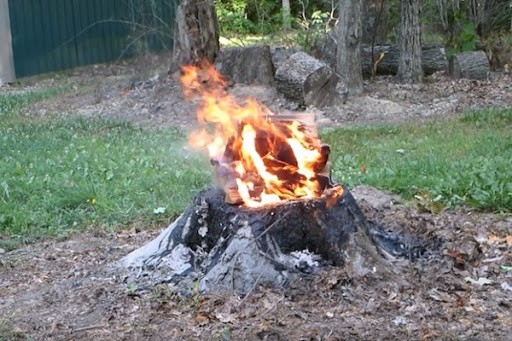
If you think axing a stump is not your cup of tea, you may burn the stump to remove it with ease.
You only need to put kerosene on the stump and let the wood soak it in. Then lit the fire like a villain in the movies.
While this method is an easy one, it comes with many risks since you’re dealing with fire.
Considerations
Before burning the palm tree stump on your property, you must consider the following:
- A potential risk for wildfire: If there’s a forest or woods near the stump, a strong wind may spread the fire to it and can go out of hand. Wildfires are hard to control and can affect so many people. Use other tree stump removal method if this is the risk for you.
- Against homeowner association rules: Living in a subdivision comes with rules. Since you’re dealing with fire, it may alert your neighbors for potential fire hazards of the activity and get you into trouble with the whole community. Believe it’s not worth the commotion. You can opt for other tree stump removal method.
- Can cause a fire in your home: Here’s nothing more at risk than your house catching fire from the burning tree stump. If the location of the stump is too near your house, don’t do this method.
- Clean air act of the city or state: Check the state regulations about burning and air quality to avoid a citation.
If the conditions above are far from what you have at home, burning the stump is an easy way for you.
Make sure to watch it burn to the last bit for safety. Hit two birds with one stone by grabbing a drink and a seat while watching the stump burn.
Method 3: Using Tree Stump Grinders To Remove Palm Tree Stumps
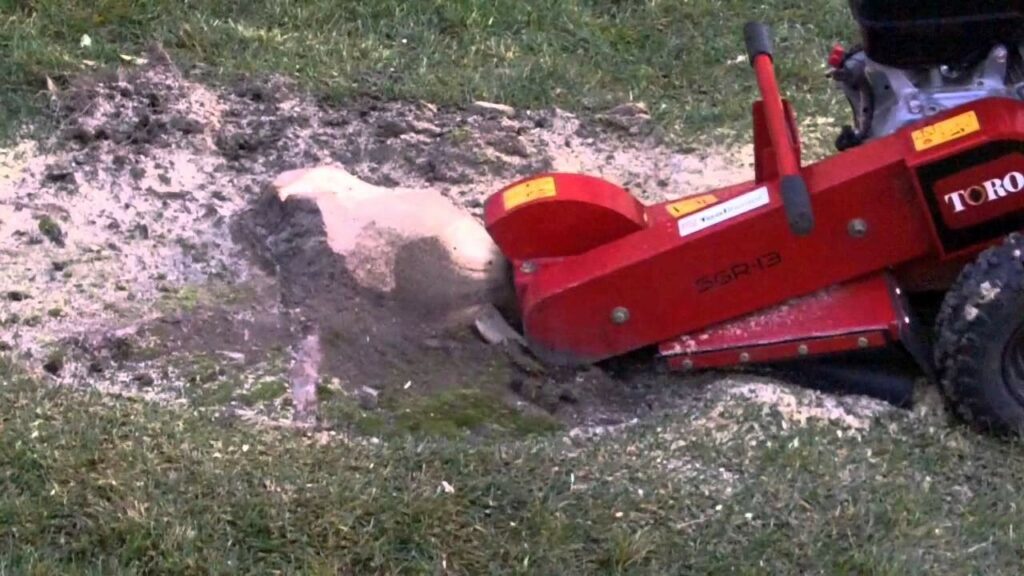
We’re now in a digital age where everything is made easier with machines, including stump removal. You may rent a stump grinder from a major hardware store like Home Depot to deal with the stump removal.
A stump grinder is a dangerous tool as it has sharp blades used for trimming the stump. Wearing safety gear is recommended starting from head protection, goggles, jacket, gloves, and protective shoes.
Here’s how you can use it:
How To Remove Tree Stumps With a Stump Grinder?
Here are the materials you’ll need:
Materials:
- Chainsaw
- Shovel
- Stump grinder
- Protective equipment
Procedure:
- Since you’ll be using the tree stump grinder, all you have to do is remove anything that may obstruct the blades during the process, like rocks around the tree stump using a shovel.
- Trim the stump to its lowest possible height using a chainsaw to speed up the process, and the grinder can only reach a certain level.
- Release the brake and press the lever of the stump grinder.
- Slowly move it towards the tree stump and see how it grinds the side of the stump. The grinder will off the wood layer by layer, so you have to move it sideways.
- You can adjust the grinder downward so you can cover the root ball of the palm tree and work your way through the roots until you finish the whole stump.
- When done, make sure to pull the brake and put the machine to the side of the work area.
- Gather all the wood chips and use them to cover the hollow left by the stump.
- Cover the area with ground soil, and voila! Problem solved!
Method 4: Rotting The Palm Tree Stump With Chemicals
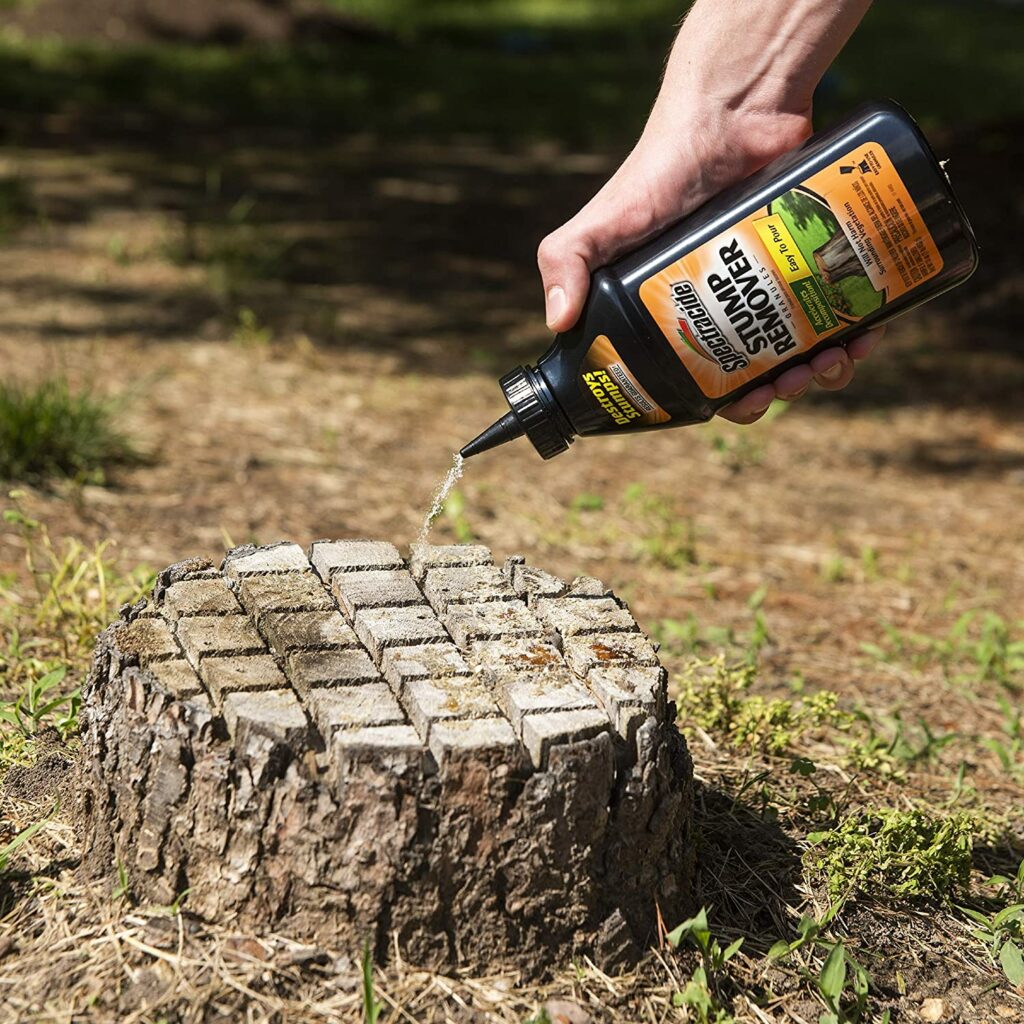
Palm tree stumps do decompose over time. However, we’re talking about months or even years.
Stump removal chemicals speed up the decomposition of the tree stump and make it easier to remove from the ground. These chemicals also help make the wood porous to make it easier to burn.
Here are some of the popular stump removal chemicals in the market:
How To Remove a Palm Tree Stump Using Chemicals
Using stump remover is, by far, one of the easiest routes in getting rid of the palm tree stump. Here’s how:
- Use a drill or a chainsaw to drill holes or slice openings on the tree stump.
- Pour the chemical into the openings based on the manufacturer label.
- Let it sit for a day or two to see the changes. Results may vary depending on the brand that you use.
Pro-tip: Opt for the environment-friendly type of stump remover chemicals to avoid damaging your surrounding plants.
Tips And Reminders For Palm Tree Stump Removal
Each stump removal method mentioned in this post comes with risks. It is up to you to choose which is more favorable to your surroundings and safer for you to do.
Here are some tips for getting rid of the unsightly stumps:
- Always wear protective clothing and equipment when handling sharp tools like axes and bladed-machinery.
- Check your city regulations and community guidelines before setting up your palm tree stump on fire.
- Keep your body at an angle away from the wood that’s being chopped off. Crowbar, pick, and ax should be handled with care to avoid injuring your hands
- Unused bladed tools and machinery should be placed at the side of the working area when you’re clearing out the wood chips. They go under the pile of chips, and you might not notice them around while walking or working on covering the ground.
Final Thoughts
Palm tree stump removal is one step in improving the landscape of your yard. The root system of the palm tree may look intimidating, but with the right tools, you can easily remove the whole stump completely.
We hope that this post gave you some ideas on how you can remove the stubborn stump on your property.
If you find this post helpful, don’t forget to share it with your friends and family, and also share with us your experience by adding a comment below.
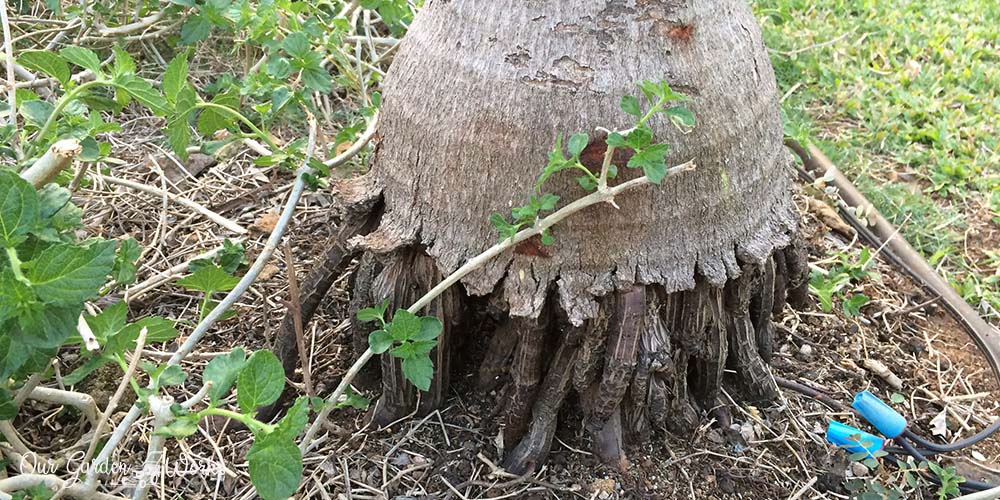
We recently removed a palm tree in our front yard. Only left the stump 6 inches below surface of dirt. Tree cutters’ grinder could not reach any further down and we were told palm trees don’t grow back. Can we grow a bush or tall flowering plants above it? Anything? Someone told us no but I read a little online and it seems like we could?
You can grow anything on the tree stump and make it useful in your garden. The goal is to make a hole at the center of the stump and create some drainage holes.
Here’s how:
Materials:
– Electric drill
– Forstner drill bit
– Auger drill bit
– Pencil
– Tape measure
– Potting soil
– Seeds or transplants
Directions:
1. Using the tape measure, mark 1 to 2 inches gap from the edge of the stump.
2. Attach the Forstner bit and start drilling the hole for the planter.
3. Remove the wood shavings as needed.
4. When you reached the ideal depth that you want for your plants, attach the auger drill bit and create drainage holes at the bottom of the planter area.
Tip: Some stumps are porous enough to drain water naturally without the need for drainage holes. However, if the wood is too dense, your plants might end up with a root rot if you don’t make some drainage holes.
Good luck and hope that helps!